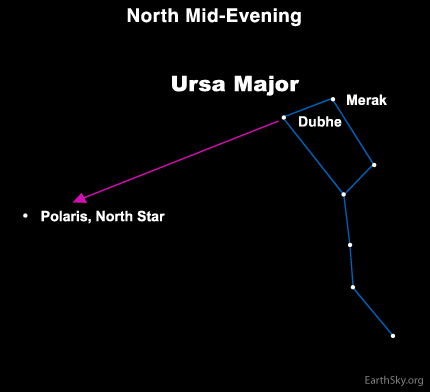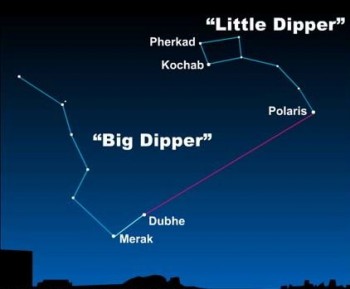what happens to the altitude of polaris as you travel northward

The North Star or Pole Star – aka Polaris – is famous for holding almost yet in our sky while the entire northern sky moves effectually it. That's considering it's located nearly at the north celestial pole, the indicate around which the entire northern sky turns. Polaris marks the mode due north. As you face Polaris and stretch your artillery sideways, your correct hand points east, and your left hand points due west. Changeabout from Polaris steers you lot due due south. Polaris is not the brightest star in the nighttime sky, as is unremarkably believed. Information technology's only about 50th brightest. Only y'all can find it easily, and, once yous exercise, you'll encounter it shining in the northern sky every night, from Northern Hemisphere locations.

In a dark state heaven, fifty-fifty when the full moon obscures a good bargain of the starry heavens, the North Star is relatively easy to see. That fact has fabricated this star a boon to travelers throughout the Northern Hemisphere, both over land and sea. Finding Polaris means y'all know the direction n.
Best of all, Polaris is readily found past using the prominent grouping of stars known equally the Large Dipper, called the Plough in the U.K., which may be the Northern Hemisphere's most famous star pattern. To locate Polaris, all you have to practise is to notice the Big Dipper arrow stars Dubhe and Merak. These two stars outline the outer part of the Large Dipper's bowl. Simply draw a line from Merak through Dubhe, and go most v times the Merak/Dubhe distance to Polaris.

The Big Dipper, like a great big hr paw, goes full circle around Polaris in 1 mean solar day. More specifically, the Big Dipper circles Polaris in a counter-clockwise direction in 23 hours and 56 minutes. Although the Large Dipper travels around Polaris all night long, the Big Dipper pointer stars always indicate to Polaris on any day of the year, and at whatsoever fourth dimension of the nighttime. Polaris marks the center of Nature's grandest celestial clock!
By the way, Polaris is famous for more reasons than ane. It's famous for hardly moving while the other stars wheel effectually information technology. And it's famous for marking the end of the Little Dipper's handle. The Little Dipper is tougher to spot in the night sky than the Big Dipper. But if you use the Big Dipper'due south pointer stars to locate Polaris, you'll be one step closer to seeing the Little Dipper.

Every bit y'all travel northward, Polaris climbs higher in the sky. If y'all go every bit far n as the North Pole, you'll see Polaris directly overhead.
As you travel southward, Polaris drops closer to the northern horizon.
If you become equally far equally the equator, Polaris sinks to the horizon.
South of the equator, Polaris drops out of the heaven.


History of Polaris. Polaris hasn't always been the Due north Star and won't remain the North Star forever. For example, a famous star chosen Thuban, in the constellation Draco the Dragon, was the Northward Star when the Egyptians built the pyramids.
Just our nowadays Polaris is a expert North Star because it'southward the sky'south 50th brightest star. So information technology's noticeable in the heaven. It served well every bit the North Star, for example, when the Europeans first sailed beyond the Atlantic over five centuries ago.
And Polaris will continue its reign equally the N Star for many centuries to come up. Information technology volition align most closely with the north angelic pole – the point in the sky direct above World'south north rotational centrality – on March 24, 2100. The computational wizard Jean Meeus figures Polaris volition be 27'09" (0.4525 degrees) from the north celestial pole at that time (a niggling less than the athwart bore of the moon when at its farthest from World).
Meanwhile, there is no visible star marking the celestial pole in the Southern Hemisphere. What's more, the Southern Hemisphere won't see a pole star appreciably shut to the south angelic pole for another 2,000 years.
At one time in man history, people literally depended on their lucky stars for their lives and livelihood. Luckily, they could trust the Big Dipper and the Due north Star to guide them. People could canvas the seas and cantankerous the trackless deserts without getting lost. When slavery existed in the United states of america, people escaping slavery counted on the Big Dipper (which they called the Drinking Gourd) to show them the North Star, lighting their manner to the free states and Canada.
While being honored as the North Star, Polaris enjoys the title of Lodestar and Cynosure also.

Polaris science. The single point of calorie-free that nosotros see every bit Polaris is actually a triple star organisation, or three stars orbiting a common center of mass. The primary star, Polaris A, is a supergiant with almost six times the mass of our sunday. A close companion, Polaris Ab, orbits 2 billion miles from Polaris. Much farther away, near the top of the illustration, is the third companion Polaris B. Polaris B is located approximately 240 billion miles from Polaris A. The 2 companion stars are the same temperature as Polaris A, but are dwarf stars.
Astronomers judge Polaris' distance at 430 low-cal-years. Because the altitude, Polaris must be a respectably luminous star. Co-ordinate to the star aficionado Jim Kaler, Polaris is a xanthous supergiant star shining with the luminosity of 2500 suns. Polaris is also the closest and brightest Cepheid variable star – a type of star that astronomers use to figure distances to star clusters and galaxies.
Polaris' position is RA: 2h 31m 48.7s, december: +89° 15′ 51″
Does Mars have a North Star?
Does the N Star ever move?
Bottom line: Polaris is the North Star – the entire northern sky wheels around it. But it's not the brightest star in the sky. In fact, Polaris ranks only 50th in effulgence.
furnellprinnybod59.blogspot.com
Source: https://earthsky.org/brightest-stars/polaris-the-present-day-north-star/